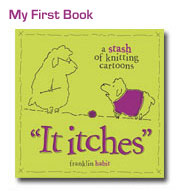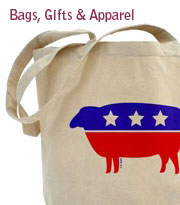I remember the first time I read a knitting blog in which the writer described how she often started projects not only without patterns, but without any fixed idea of what she was going to make. She said something akin to, "I just pick up the needles and watch what happens."
That gave me chills.
Back then, I was newly emerged from long, dark years of knitting the same scarf and mittens over and over in solitude, using whatever yarn I happened to find. My proudest technical achievement was figuring out on my own how to work the thumb gore in the mitten pattern. It was incomprehensible to me that person could use yarn and needles as a sketchbook. I'd been "making up" stuff for years on paper; but what sort of freaky genius would you need to be to doodle with
wool?
As it turns out, you don't really need to be genius, and I'm proof. When I put up the pictures of Abigail's
Sheep in the Meadow sweater, this question came to mind because several of you were kind enough to ask how I'd made the sheep for the pocket. I realized I had no handy answer, because I improvised as I went along. I'd doodled with wool, or in this case a wool/cotton blend. Fancy that.
I've decided it boils down to having these things at your command:
- enough curiosity to want to deviate from written patterns, or make up your own;
- a willingness to pause and examine what's in front of you;
- a willingness to try different approaches until you create what pleases you;
- a working knowledge of basic moves in knitting, including increases, decreases, and the basic effects on the fabric created by knit, purl, and y/o;
- patience; and
- the understanding that it's just knitting, it's done one stitch at a time at your own pace, and you can undo it if you don't like it.
Since you asked, I 'm going to press my mental rewind button and see if I can reconstruct how I did it.
Mind you, this may prove incredibly boring. But as you asked for it, you have only yourself to blame.
The task before us is:
Knit a lamb to be attached, as appliqué, to the pocket of a baby sweater.
Step One: Take a Good Look at Your SubjectI'm a firm believer in a dictum often expressed by Charles M. Schulz, creator of
Peanuts and a personal household god: if you can't draw it realistically, you can't cartoon it convincingly.
Not that you must be able to sketch a photorealistic lamb in order to knit one. No.
But if you're trying to simplify an object in order to render it in stitches, you
should have the level of familiarity that comes of from c
losely examining the original. You can't show everything, so you'll have to determine what the absolutely essential details are. What makes a lamb look like a lamb?
So, in case you don't have a flock in the backyard, here's a photograph of a lamb. (You may pause to say, "Awwwwwwwwww.")

Wait–who said, "Pass the mint sauce?"
That's not my own sheep; I found it
online. When you need reference material in a hurry, Google's image search function is your friend. Just be forewarned: seemingly innocent queries like "sheep" or "cupcake" can yield shocking results. Turn on the "safe search" filter if you have a low tolerance for surprises.
Usually, when I'm drawing an object I haven't worked with a whole lot, I don't just look at one picture. If possible, I seek out the real thing and make sketches or photographs on the spot. If that's impossible, I look over photographs of as many as I can in order to synthesize in my head what the essential characteristics are.
In the case of the lamb, you might decide after some concentrated looking that these characteristics communicate "lamb" visually:

Or you might find yourself focused on other aspects. There are no correct answers. This is your lamb, seen through your eyes. You will find your own path to lambishness.
Step Two: Establish a Simple SilhouetteUsually it's the shape or outline of the object, also called the silhouette, that most efficiently communicates at a glance what one is looking at. I find this to be especially true of animals.
Smaller details, like noses, are often suprisingly similar even across species. Here are two noses from that perennially opposed pair, the lion and the lamb.

Simplify them, as in a cartoon, and the similarity is even greater.

Silhouettes are another story. Pull back to reveal the full outline of the head, and you're never going to mistake these two for cousins, even with all other details removed.

Since in this case we're knitting a small, flat item at a relatively large gauge (about five stitches to the inch), our silhouette is extremely important–there won't be much room for smaller details. Furthermore, the silhouette must be reduced to its absolute basics–the
simplest and
fewest geometric forms.
So, as the final step for today's entry, here's how you might see the major outlines of the sheep you intend to knit.
You need a head.

And you need a body.

Together, they look like this.

Next time, we pick up the needles.
I hope you can bear the suspense.































